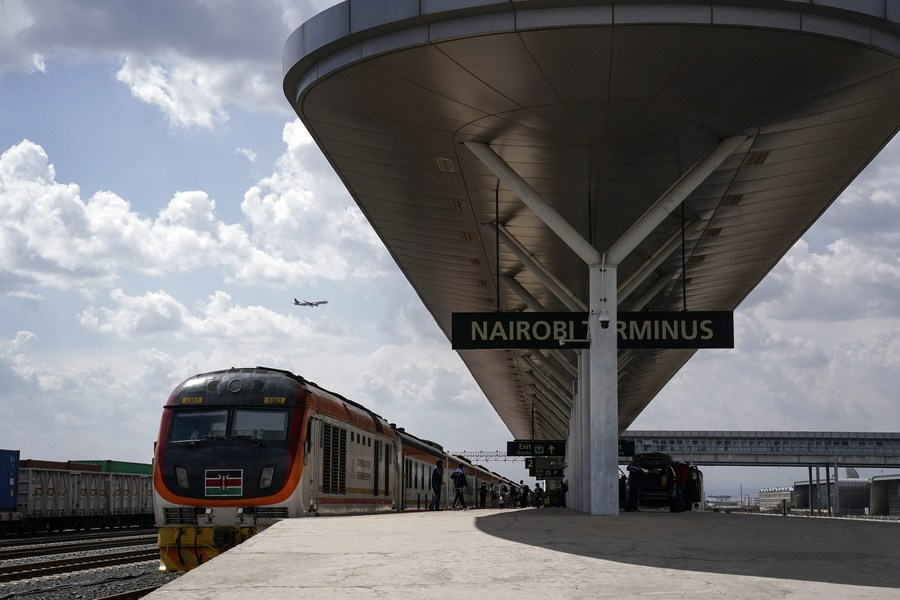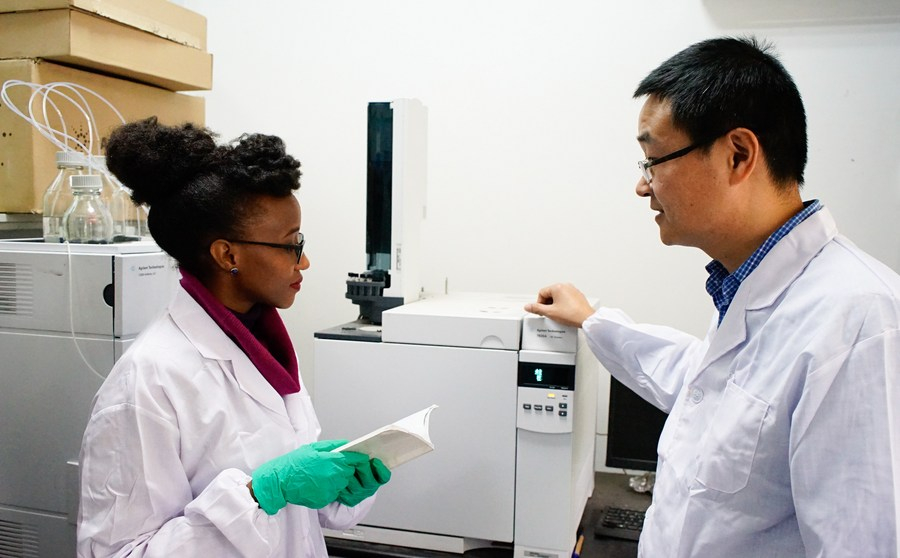How the Belt and Road Initiative has bolstered Kenya's economic and social development

Aerial photo taken on Dec. 13, 2019 shows the 50 MW solar power farm in Garissa, Kenya. The plant, designed and built by the EPC contractor China Jiangxi Corporation for International Economic and Technical Co-operation (CJIC), in conjunction with Kenya's Rural Energy Authority (REA), is one of the largest photovoltaic electricity stations in Africa. [Xinhua/Xie Han]
"Were it not for the BRI, many of the development fruits that Kenya and other African countries are enjoying would not have been possible, at least not in such a relatively short time," said an African expert.
by Xinhua writers Daniel Ooko, Li Hualing
NAIROBI -- Lives have improved for Kenyans following the successful implementation of the China-proposed Belt and Road Initiative (BRI).
Tens of Chinese investors have set foot in Kenya, while hundreds of young Kenyan students have traveled to China to study, with most on scholarships.
Experts agree that the BRI has accelerated the adoption of Chinese technology that meets local challenges in Kenya and many other African countries.
INFRASTRUCTURE
In just a decade since the BRI launch, Chinese firms have built ports and railway lines and spruced up airports in Kenya, catalyzing business due to growing industry demand.
Peter Kagwanja, the chief executive officer of the Africa Policy Institute, a regional think tank on China-Africa relations, said Kenya's business and service sectors have rapidly benefited from improved infrastructure.
Tourists traveling between the capital of Nairobi and the coastal city of Mombasa in Kenya have found using the Standard Gauge Railway (SGR) convenient and affordable. More than 10 million passengers have used the "Madaraka Express" trains plying the route since its launch in 2017, with annual usage set to hit a new high of nearly 3 million passengers in 2023, according to the Kenya Railways Corporation.
Similarly, the SGR cargo train has become a preferred choice for businesses seeking to move their cargo from the Port of Mombasa to further inland and beyond the borders.
The SGR trains have hauled over 26 million tons of cargo since the service was started in 2018, according to the Kenya Railways Corporation.

This photo taken on Sept. 20, 2023 shows a train leaving for Mombasa waiting at the Nairobi Terminus Station of the China built Mombasa-Nairobi Standard Gauge Railway (SGR) in Nairobi, Kenya. (Xinhua/Han Xu)
"A project like the SGR has ensured that the link between peace and development is established and sustained," Kagwanja said. "The BRI infrastructure development not only connects Kenya but also its neighbors and the Horn of Africa region, facilitating trade, cultural exchange and development."
The Nairobi Expressway, a four-lane highway designed and implemented by Chinese contractors in the heart of Nairobi city, has eased traffic congestion on Kenya's northern corridor, a key route for the movement of people and exports.
The 27-km expressway has cut travel time across the city from two hours to 20 minutes, with over 20 million vehicles having used the thoroughfare in just one year, according to the MOJA Expressway Company, the firm operating the toll-fee road.
The Kenyan government has been seeking to ease infrastructure shortfalls in the country, and this project serves as a prime example of the public-private infrastructure model.
Kenyan young man David Maina Kamore is another beneficiary of the initiative. After years of professional study in China, Kamore returned to Kenya in 2014. He was soon employed at China Aerospace Construction Group Co., Ltd, where he works as a transmission engineer. Kamore said that he is on a team that is currently undertaking the Kenya Power Transmission Expansion Project, which aims to widen access to reliable electricity supply for previously underserved areas.
"Were it not for the BRI, many of the development fruits that Kenya and other African countries are enjoying would not have been possible, at least not in such a relatively short time," said Karani Muthamia, the founder and director of the China-Africa Liaison Centre.
There has been a massive exchange of knowledge and skills between the Chinese and local experts in Kenya. "China has introduced modern technology in all sectors, cheaper ways of running developmental projects, and, importantly, a much shorter period of carrying out monumental projects," said Muthamia.
DIGITAL ECONOMY
Improved digital infrastructure has ushered in a new development phase in Kenya's economy -- Internet connectivity is more efficient; businesses are backed with modern telecommunications technology systems; governance has moved to electronic platforms; and local and international consumers can buy and sell goods online.
Working with Chinese technology giant Huawei, Safaricom, Kenya's largest mobile telecommunications operator, has developed and launched an innovative mobile money transfer system.
Chinese firms are further aiding Kenya in developing its technology city, Konza Technopolis, in Machakos County, about 60 km south of the capital, Nairobi.
Installing high-speed internet infrastructure and providing high-quality smart devices by Chinese firms have made it possible for Kenyans to engage and do business in the country and beyond the borders.
"BRI has helped accelerate Kenya's development by going back to the fundamentals of economic-building," Abukar Arman, a former Somali diplomat, geopolitical analyst, and author of the book Broken Camel Bells, told Xinhua.
"No country could enhance its trade, attract investors and genuinely develop its economy without certain critical infrastructure. China has not only built information technology infrastructure but also railways, paved roads, ports, hospitals, schools and electric grids across Africa," Arman said.

A researcher of Sino-Africa Joint Research Centre that is affiliated with Chinese Academy of Sciences (CAS) teaches Kenyan Teresiah Mungai using the experimental apparatus at Wuhan Botanical Garden of CAS in Wuhan, central China's Hubei Province, March 21, 2017.[Xinhua/Kang Kejing]
AGRICULTURE
China has also actively supported African countries in agriculture to boost productivity and build a strong defense against food insecurity.
In Kenya, the agricultural industry, a key driver of growth, employs 65-70 percent of the labor force and typically accounts for about 30 percent of GDP, according to the World Bank.
China has supported the modernization of Kenya's agriculture sector by initiating frequent exchanges of knowledge and technology between the agricultural institutions of both countries.
Chinese institutions have created linkages with Kenya's research centers on breeding high-yielding seed varieties and curbing diseases. Furthermore, many Kenyan students have traveled to China to study agriculture at various universities.
Originated from China's arid Loess Plateau, the agricultural technology of all-film double-furrow sowing, has now been applied to agricultural production in Kenya based on local conditions to help relieve the impact of severe drought on food production.
The Sino-Africa Joint Research Centre is hosted at Kenya's Jomo Kenyatta University of Agriculture and Technology. Here, China has helped Kenya hone exceptional talent in areas such as biodiversity conservation, precision agriculture and climate mitigation.
In November 2022, researchers from the two nations collectively identified ways to increase the productivity of a local maize variety farmed in dry areas by 50 percent.
Victoria Ngumi, the university's vice-chancellor, noted recently that the new maize production technology at the joint research center could further enhance Kenya's food security while protecting the environment.
























